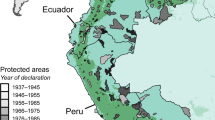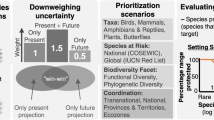Abstract
The Fifth World Parks Congress in Durban, South Africa, announced in September 2003 that the global network of protected areas now covers 11.5% of the planet's land surface1. This surpasses the 10% target proposed a decade earlier, at the Caracas Congress2, for 9 out of 14 major terrestrial biomes1. Such uniform targets based on percentage of area have become deeply embedded into national and international conservation planning3. Although politically expedient, the scientific basis and conservation value of these targets have been questioned4,5. In practice, however, little is known of how to set appropriate targets, or of the extent to which the current global protected area network fulfils its goal of protecting biodiversity. Here, we combine five global data sets on the distribution of species and protected areas to provide the first global gap analysis assessing the effectiveness of protected areas in representing species diversity. We show that the global network is far from complete, and demonstrate the inadequacy of uniform—that is, ‘one size fits all’—conservation targets.
This is a preview of subscription content, access via your institution
Access options
Subscribe to this journal
Receive 51 print issues and online access
$199.00 per year
only $3.90 per issue
Buy this article
- Purchase on Springer Link
- Instant access to full article PDF
Prices may be subject to local taxes which are calculated during checkout


Similar content being viewed by others
References
Chape, S., Fish, L., Fox, P. & Spalding, M. United Nations List of Protected Areas (IUCN/UNEP, Gland, Switzerland/Cambridge, UK, 2003)
The World Conservation Union. Parks For Life: Report of the IVth World Congress on National Parks and Protected Areas (IUCN, Gland, Switzerland, 1993)
Kamden-Toham, A. et al. Forest conservation in the Congo Basin. Science 299, 346 (2003)
Soulé, M. E. & Sanjayan, M. A. Conservation targets: do they help? Science 279, 2060–2061 (1998)
Pressey, R. L., Cowling, R. M. & Rouget, M. Formulating conservation targets for biodiversity pattern and process in the Cape Floristic Region, South Africa. Biol. Conserv. 112, 99–127 (2003)
Margules, C. R. & Pressey, R. L. Systematic conservation planning. Nature 405, 243–253 (2000)
Scott, J. M. et al. Gap analysis—a geographic approach to protection of biological diversity. Wildl. Monogr. 123, 1–41 (1993)
Lacher, T. E. Jr in GIS Methodologies for Developing Conservation Strategies (eds Savitsky, B. G. & Lacher, T. E. Jr) 199–209 (Columbia Univ. Press, New York, 1998)
Jennings, M. D. Gap analysis: Concepts, methods, and recent results. Landscape Ecol. 15, 5–20 (2000)
Scott, J. M. et al. Nature reserves: Do they capture the full range of America's biological diversity? Ecol. Appl. 11, 999–1007 (2001)
Andelman, S. J. & Willig, M. R. Present patterns and future prospects for biodiversity in the Western Hemisphere. Ecol. Lett. 6, 818–824 (2003)
Pressey, R. L. Ad hoc reservations—Forward or backward steps in developing representative reserve systems? Conserv. Biol. 8, 662–668 (1994)
Newmark, W. D. Insularization of Tanzanian parks and the local extinction of large mammals. Conserv. Biol. 10, 1549–1556 (1996)
Peres, C. A. & Lake, I. R. Extent of nontimber resource extraction in tropical forests: accessibility to game vertebrates by hunters in the Amazon basin. Conserv. Biol. 17, 521–535 (2003)
The World Conservation Union, Guidelines for Protected Area Management Categories (IUCN CNPPA/WCMC, Gland, Switzerland/Cambridge, UK, 1994)
Stattersfield, A. J., Crosby, M. J., Long, A. J. & Wege, D. C. Endemic Bird Areas of the World—Priorities for Biodiversity Conservation (BirdLife International, Cambridge, UK, 1998)
BirdLife International. Threatened Birds of the World (Lynx Edicions/BirdLife International, Barcelona/Cambridge, UK, 2000)
The World Conservation Union. IUCN Red List of Threatened Species [online] 〈http://www.redlist.org〉 (2003)
Bruner, A. G., Gullison, R. E., Rice, R. E. & Fonseca, G. A. B. Effectiveness of parks in protecting tropical biodiversity. Science 291, 125–128 (2001)
Thomas, C. D. et al. Extinction risk from climate change. Nature 427, 145–148 (2004)
Olson, D. M. et al. Terrestrial ecoregions of the world: A new map of life on earth. Bioscience 51, 933–938 (2001)
Myers, N., Mittermeier, R. A., Mittermeier, C. G., Fonseca, G. A. B. & Kent, J. Biodiversity hotspots for conservation priorities. Nature 403, 853–858 (2000)
Green, M. J. B. & Paine, J. State of the World's Protected Areas at the End of the Twentieth Century (WCMC, Cambridge, UK, 1997)
Rodrigues, A. S. L. & Gaston, K. J. How large do reserve networks need to be? Ecol. Lett. 4, 602–609 (2001)
Gaston, K. J. Global patterns in biodiversity. Nature 405, 220–227 (2000)
Cowling, R. M. & Pressey, R. L. Rapid plant diversification: planning for an evolutionary future. Proc. Natl Acad. Sci. USA 98, 5452–5457 (2001)
Gaston, K. J. & May, R. M. Taxonomy of taxonomists. Nature 356, 281–282 (1992)
Balmford, A. et al. Economic reasons for conserving wild nature. Science 297, 950–953 (2002)
World Database on Protected Areas. World Database on Protected Areas (IUCN-WCPA/UNEP-WCMC, Washington DC, 2003)
Iverson, J. B., Kiester, A. R., Hughes, L. E. & Kimerling, A. J. The EMYSystem World Turtle Database 2003 [online] 〈http://emys.geo.orst.edu〉 (2003)
Acknowledgements
We thank the Moore Family Foundation, the Howard Gilman Foundation and the National Center for Ecological Analysis and Synthesis of the University of California Santa Barbara for support. The analysis was possible thanks to the combined effort of the thousands of individuals and hundreds of institutions who collected and compiled the data, or provided financial support for such efforts. We are grateful to the numerous individuals who contributed to this analysis, especially to K. Buhlmann, S. Butchart, N. Cox, P. P. van Dijk, J. Iverson, R. Kiester, T. Lacher and B. Young. H. Possingham made valuable comments on the manuscript. Figure 1 was generated by J. Seeber.
Author information
Authors and Affiliations
Corresponding author
Ethics declarations
Competing interests
The authors declare that they have no competing financial interests.
Supplementary information
Supplementary Information
Notes on: data sources and limitations; background information regarding targets based on percentage of area protected; confidence intervals for species coverage in networks of randomly distributed protected areas; comparison between protected and unprotected sites in terms of richness of all species, threatened species, and restricted-range species; and extended acknowledgements. (PDF 339 kb)
Rights and permissions
About this article
Cite this article
Rodrigues, A., Andelman, S., Bakarr, M. et al. Effectiveness of the global protected area network in representing species diversity. Nature 428, 640–643 (2004). https://doi.org/10.1038/nature02422
Received:
Accepted:
Issue Date:
DOI: https://doi.org/10.1038/nature02422
This article is cited by
-
How effective are protected areas for reducing threats to biodiversity? A systematic review protocol
Environmental Evidence (2023)
-
Global conservation prioritization areas in three dimensions of crocodilian diversity
Scientific Reports (2023)
-
Protected areas slow declines unevenly across the tetrapod tree of life
Nature (2023)
-
Predicting climate heating impacts on riverine fish species diversity in a biodiversity hotspot region
Scientific Reports (2023)
-
Spatial patterns of phylogenetic and species diversity of Fennoscandian vascular plants in protected areas
Biodiversity and Conservation (2023)
Comments
By submitting a comment you agree to abide by our Terms and Community Guidelines. If you find something abusive or that does not comply with our terms or guidelines please flag it as inappropriate.



